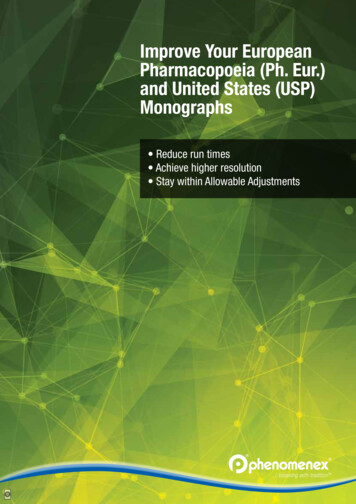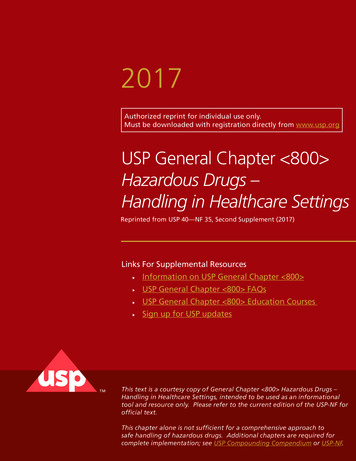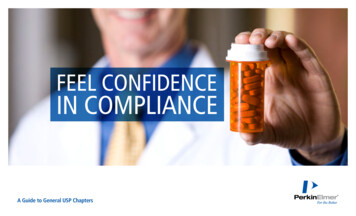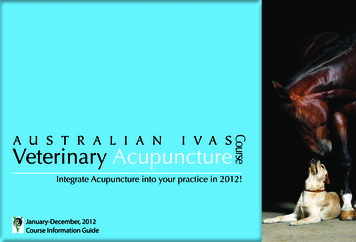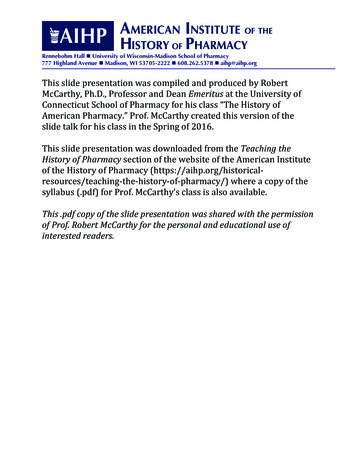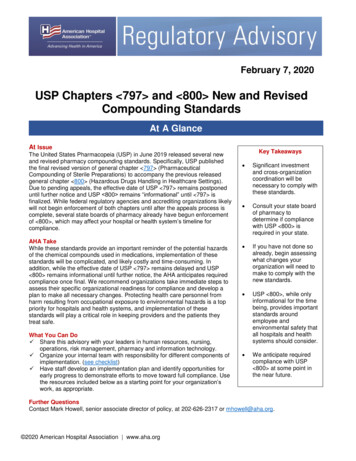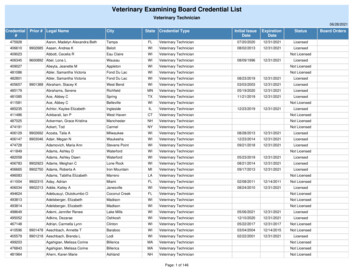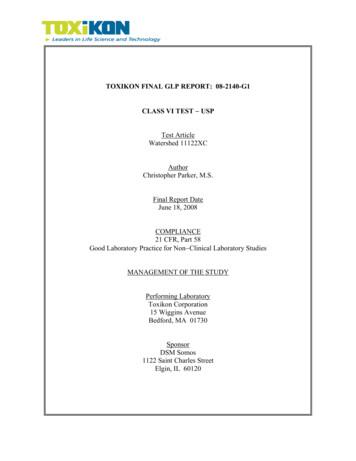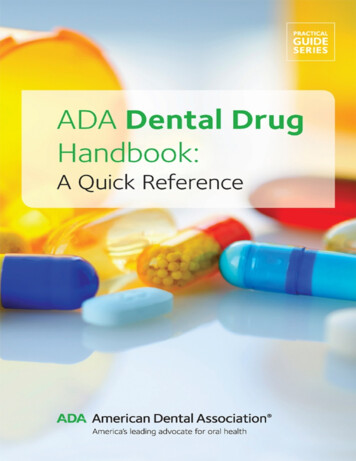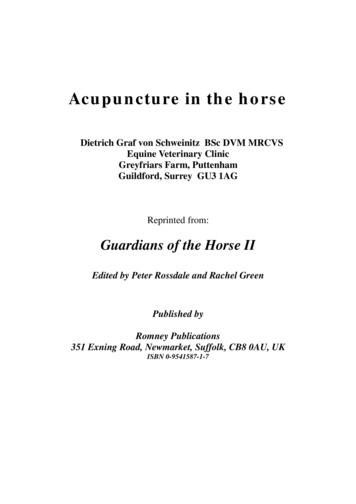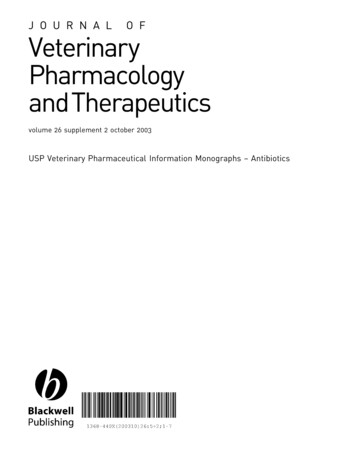
Transcription
volume 26 supplement 2 october 2003USP Veterinary Pharmaceutical Information Monographs – Antibiotics
USP VETERINARY PHARMACEUTICAL INFORMATION MONOGRAPHS – ANTIBIOTICSCONTENTSv1IntroductionAminoglycosides (Veterinary—Systemic)33Aminopenicillins s (Veterinary—Systemic)46Amoxicillin and Clavulanate (Veterinary—Systemic)51Cephalosporins (Veterinary—Systemic)71Cephapirin (Veterinary—Intramammary-Local)74Chloramphenicol (Veterinary—Systemic)79Erythromycin (Veterinary—Intramammary-Local)81Florfenicol (Veterinary—Systemic)87Fluoroquinolones (Veterinary—Systemic)109Lincosamides (Veterinary—Systemic)119Macrolides (Veterinary—Systemic)144Metronidazole (Veterinary—Systemic)149Penicillin G (Veterinary—Intramammary-Local)151Penicillin G (Veterinary—Systemic)161Pirlimycin (Veterinary—Intramammary-Local)164Potentiated Sulfonamides (Veterinary—Systemic)185Pyrimethamine (Veterinary—Systemic)191Rifampin (Veterinary—Systemic)202Spectinomycin (Veterinary—Systemic)207Sulfonamides (Veterinary—Systemic)225Tetracyclines (Veterinary—Systemic)253Indications Index257Dosing Index262Veterinary Brand and Generic Name Index269Human Brand and Generic Name Index
Introduction vIntroductionWHAT’S DIFFERENT ABOUT A USP DRUG INFORMATIONMONOGRAPHThe Veterinary Medicine Expert Committee on Drug Informationgratefully acknowledges the financial support of its parent organization, the United States Pharmacopeia, to publish these monographs. Italso is appreciative to the Food Animal Residue Avoidance Databank(FARAD) for supplying slaughter and milk withdrawal informationwhere extra-label drug use in food animals is noted. This information isprovided in cooperation with MICROMEDEX, a Thomson HealthcareCompany.USP history, organizational structure, and publicationsIn pursuit of its mission to promote public health, the United StatesPharmacopeia (USP) develops authoritative information about theappropriate use of medicines, including those used in animals. Thisnon-government, not-for-profit organization draws on a long-standingdedication to public involvement in the establishment of scientificstandards. USP achieves its goals through the contributions ofvolunteers representing health care professions, as well as science,academia, the U.S. government, the pharmaceutical industry, andconsumer organizations.USP was established in 1820 with the primary goal of setting standardsfor the identity, strength, and quality of medicinal compounds and thisremains at the core of the organization. Currently, USP providesstandards for more than 3,800 prescription and non-prescriptiondrugs, nutritional and dietary supplements, veterinary drugs, andhealth care products. These standards are published in the UnitedStates Pharmacopeia (USP) and the National Formulary (NF), which areofficially recognized in the Federal Food, Drug, and Cosmetic Act (21U.S.C. § 321 et seq.). USP also produces Reference Standards, whichare an integral part of USP’s standards program.The development of USP information on the best use of medications wasbegun in 1970, growing out of the public process of developing qualitystandards. USP information advisory panels were created to assurethat the information under development is evidence-based, consensusestablished, practical, and clinically relevant. This work was expandedinto a separate public health program and in 1980, the first USP DI was published. Today, in association with MICROMEDEX, USPcontinues to provide oversight and approval of drug informationcontent in the USP DI database, which covers nearly all medicines inthe U.S. and Canada.The veterinary drug information monograph creation processVery soon after the USP DI was first published, an advisory panel onveterinary medicine was created. Since 1982, veterinary pharmacologists, veterinary pharmacists, and other specialists have contributedtheir time and expertise in creating and revising drug informationthrough USP’s unique process. This drug information is developed byexhaustive compilation of approved product label information and alsocollection and analysis of publicly available data on each drug fromresearch studies and clinical reports. Careful attention is paid todifferentiating species-specific information. With the agreement ofMICROMEDEX, information from the human USP DI database is 2003 Thomson MICROMEDEXincluded where it may be helpful. Each draft chapter or monograph isthen put through a review process that includes USP VeterinaryMedicine Committee members, regulatory representatives, pharmaceutical manufacturers, ad hoc specialists, and public review. Atpresent, USP monographs are the only drug information source inveterinary medicine undergoing such extensive expert review,a process through which the credibility of the information ismaintained.USP drug information is a work-in-progress. The information is inconstant revision and is a continuous collection of the currentjudgments of experts in the use of medications. The following chaptershave been developed over 7 years, with information added and revised,as necessary.Unique featuresThis special issue of the Journal of Veterinary Pharmacology andTherapeutics contains a series of drug information monographs onantimicrobials used in veterinary medicine. What makes thisinformation different from other sources of veterinary drug information? A succinct listing would include: The incorporation of extra-label and label indications and dosagesfor all domestic species. See the section below, ‘‘Finding the specificdrug information you need; Label and extra-label uses,’’ for detailson how this information is differentiated. The inclusion of slaughter and milk withdrawals when extra-labeldrug use in food animals is considered an acceptable option fortherapy. Withdrawal times have been provided by FARAD for thespecified conditions noted. The inclusion of information about both U.S. and Canadianveterinary drug products. The grouping of indications into three categories. The ‘‘Accepted’’category indicates that clear evidence exists to support use of thedrug for a particular purpose. ‘‘Acceptance not established’’(potentially useful) indicates that use of the drug for an indicationmay be worthy of consideration if superior therapies do not exist,but the evidence is either scant or subject to concern based onexperimental design. If a use is viewed as ineffective or has beenreplaced by clearly superior therapies, the indication is deemed‘‘Unaccepted.’’ These categorizations are applied to label and extralabel uses. The use of tables of scientific evidence to address controversial issuesduring the review process, particularly relative to extra-label druguse. Review of the information by a Food and Drug Administration (FDA)liaison to the committee. Although comments made by the FDA aretaken quite seriously, those opinions are nonbinding on the USP.The information contained in these monographs should not beconsidered an endorsement or ‘‘acceptance’’ by the FDA as to agiven use or dosage. The review of each monograph by the USP Veterinary MedicineCommittee. This committee consists of 10 to 15 volunteersrecognized as experts in pharmacology, internal medicine, or speciesdiscipline(s).All rights reserved
vi IntroductionFinding the specific drug information you needACKNOWLEDGEMENTSLabel and extra-label usesThe following individuals are recognized for their contributions andsupport towards the production of this body of work:The Indications section of each drug monograph is designed to provideinformation about indications in drug product labeling in the U.S. andCanada. Extra-label indications for which clinical and research datahave been evaluated are also included. Indications found in productlabeling are listed first. Brackets around an indication signify that it isnot found in any product labeling in the U.S. at the time of last majorrevision. Some indications are followed by a superscript 1, meaningthey are not included in Canadian product labeling.Examples of bracket and superscript 1 placement in the monographs:[Pneumonia, bacterial (treatment)] An extra-label use in the U.S.An indication is included inCanadian product labeling.An indication found in U.S.Pneumonia, bacterial (treatment)1product labeling but not inCanadian product labeling.[Pneumonia, bacterial (treatment)]1 An extra-label use in both theU.S. and Canada.Species and dosage formsWithin each category of the Indications section the information is arrangedin a hierarchy as follows: indication, followed by the species to whichthat indication applies, and finally the dosage forms used in that speciesfor that indication. You will see that some species and dosage forms arealso given bracket and superscript 1 designations; these have the samemeaning for species and dosage forms as described above for indications.To decrease clutter and confusion, only the highest level of the hierarchyis given a bracket or superscript 1 (indication species dosage form).That is, if the indication is not found on any label in the U.S. (abracketed, extralabel use) then the species under it will not be bracketedbecause it is obvious that no species are on the label of any product in theUnited States for this indication.DosingIn the USP veterinary drug information monographs, dosage forms arealways listed separately to provide an opportunity to list specificinformation for each type of product. In the Dosage Forms section,indications and species are bracketed or given a superscript 1 followingthe same rules applied in the Indications section, except that they reflectthe labeling of the specific dosage form. Dosages listed are not alwayslabel dosages even if the species is in the product labeling.Label and extra-label withdrawal timesEstablished withdrawal times from product labeling are listed in the Withdrawaltimes tables for each dosage form labeled for use in food-producing animals.But be sure to consult the approved labeling on the product you are using forthe specific government established dose and withdrawal time.Extra-label withdrawal times are listed in the Withdrawal times section foreach extra-label use and/or dose recommended for food-producing animals.As always, veterinarians will use their own clinical judgment, following theguidelines of the Animal Medicinal Drug Use Clarification Act, to determinea safe extra-label withdrawal time.Cory Langston, DVM, PhD, DACVCPChair, USP Veterinary Medicine Expert Committee on DrugInformation 2003 Thomson MICROMEDEXUSP StaffRoger Williams, MD (CEO and Executive Vice President, USP)Ian DeVeau, PhD (Senior Scientist, Veterinary Drugs, Information andStandards Development, USP)Amy S. Neal, DVM (USP consultant, writer and editor)Jerome A. Halperin, BS, MPH, MS (former CEO and Executive VicePresident, USP)Keith Johnson (former Director, Drug Information Division, USP)David Nash, DVM (former Director, Veterinary Medicine, Informationand Standards Development, USP)E. Kathryn Meyer, VMD (former Drug Information Specialist andCoordinator, Veterinary Practitioners’ Reporting Program,USP)2000 to 2005 Veterinary Medicine CommitteeCory Langston, DVM, PhD, DACVCP, ChairMichael D. Apley, DVM, PhD, BS, DACVCPDawn M. Boothe, BS, MS, DVM, PhD, DACVCP, DACVIMTerrence P. Clark, DVM, PhD, DACVCPGigi F. Davidson, BS, RPh, DICVPPatricia Dowling, DVM, MS, DACVIM, DACVCPDouglas T. Kemp, PharmD, DICVPMark G. Papich, DVM, MS, BS, DACVCPM. Gatz Riddell, DVM, MSJim E. Riviere, DVM, PhD, MS, BSRoderick C. Tubbs, DVM, PhDJeff R. Wilcke, DVM, MS, DACVCP1995 to 2000 Veterinary Medicine Advisory PanelCory Langston, DVM, PhD, DACVCP, ChairMichael D. Apley, DVM, PhD, BS, DACVCPGordon Brumbaugh, DVM, PhD, DACVCPThomas Burkgren, DVM, MBACynthia T. Culmo, RPhLloyd E. Davis, PhD, DVMPatricia Dowling, DVM, MS, DACVIM, DACVCPStuart Forney, RPh, MSAntoinette D. Jernigan, DVM, PhD, DACVCPMark G. Papich, DVM, MS, DACVCPThomas E. Powers, DVM, PhDJim E. Riviere, DVM, PhDCharles R. Short, DVM, PhD, DACVCPHector Sumano Lopez, DVM, PhDJeff R. Wilcke, DVM, MS, DACVCP1990 to 1995 Veterinary Medicine Advisory PanelLloyd E. Davis, DVM, PhD, ChairArthur L. Aronson, DVM, PhDGordon Brumbaugh, DVM, PhD, DACVCPGordon L Coppoc, DVM, PhDSidney A. Ewing, DVM, PhDStuart D. Forney, RPh, MSWilliam G. Huber, DVM, PhDWilliam L. Jenkins, DVM, PhD, DACVCPAll rights reserved
Introduction viiCory Langston, DVM, PhD, DACVCPMark G. Papich, DVM, MS, DACVCPJohn W. Paul, DVM, PhDThomas E. Powers, DVM, PhD, DACVCPCharles R. Short, DVM, PhD, DACVCPRichard H. Teske, DVM, PhDJeff R. Wilcke, DVM, MS, DACVCP1985 to 1990 Panel on Veterinary MedicineLloyd E. Davis, PhD, DVM, ChairArthur L. Aronson, DVM, PhDNicholas H. Booth, DVM, PhDGordon L Coppoc, DVM, PhDSidney A. Ewing, DVM, PhDStuart D. Forney, RPh, MSDiane K. Gerken, DVM, PhDWilliam G. Huber, DVM, PhDWilliam L. Jenkins, DVM, PhDRobert W. Phillips, DVM, PhDThomas E. Powers, DVM, PhDCharles R. Short, DVM, PhDRichard H. Teske, DVM, PhDJeff R. Wilcke, DVM, MSArthur L. Aronson, DVM, PhDNicholas H. Booth, DVM, PhDGordon L Coppoc, DVM, PhDGeorge T. Edds, DVM, PhDSidney A. Ewing, DVM, PhDPeter A. Eyre, BVMS, PhDStuart D. Forney, RPh, MSWilliam G. Huber, DVM, PhDRobert W. Phillips, DVM, PhDThomas E. Powers, DVM, PhDI.A. Schipper, DVM, PhDRichard H. Teske, DVM, PhDFor more information about USP Veterinary PharmaceuticalInformation monographs you may contact:Ian F. DeVeau, PhDUnited States Pharmacopeia12601 Twinbrook ParkwayRockville, Maryland 20852United StatesTelephone number: 1-301-881-0666E-mail: ifd@usp.orgwww.usp.org1983 to 1985 Panel on Veterinary MedicineLloyd E. Davis, PhD, DVM, ChairH. Richard Adams, DVM, PhD 2003 Thomson MICROMEDEXAll rights reserved
AMINOGLYCOSIDES Veterinary—Systemic 1AMINOGLYCOSIDES Veterinary—SystemicThis monograph includes information on the following aminoglycosideaminocyclitols: Amikacin; Dihydrostreptomycin*; Gentamicin; Kanamycin ; Neomycin; Streptomycin . It also contains information on thefollowing aminocyclitol: Apramycin.Some commonly used brand names are:Amifuse E [Amikacin]Amiglyde-V [Amikacin]Amiglyde-V Injection [Amikacin]Amiglyde-V Intrauterine Solution[Amikacin]Amiject D [Amikacin]Amikacin C Injection [Amikacin]Amikacin E Solution [Amikacin]AmTech AmiMax C Injection [Amikacin]AmTech AmiMax E Solution [Amikacin]AmTech GentaMax 100 [Gentamicin]AmTech Gentamicin Sulfate PigPump Oral Solution [Gentamicin]AmTech Gentapoult [Gentamicin]AmTech Neomycin Oral Solution[Neomycin]Apralan [Apramycin]Apralan Soluble [Apramycin]Biosol Liquid [Neomycin]CaniGlide [Amikacin]Equi-Phar EquiGlide [Amikacin]Ethamycin [Dihydrostreptomycin]Garacin Pig Pump [Gentamicin]Garacin Piglet Injection [Gentamicin]Garacin Soluble Powder [Gentamicin]Garasol Injection [Gentamicin]Garasol Pig Pump Oral Solution[Gentamicin]Garasol Solution Injectable [Gentamicin]Gen-Gard [Gentamicin]Genta-fuse [Gentamicin]GentaMax 100 [Gentamicin]GentaVed 50 [Gentamicin]GentaVed 100 [Gentamicin]Gentocin [Gentamicin]Gentocin Solution [Gentamicin]Gentocin Solution Injectable[Gentamicin]Gentozen [Gentamicin]Kantrim [Kanamycin]Legacy [Gentamicin]Neo-325 [Neomycin]Neomed 325 [Neomycin]Neomix 325 [Neomycin]Neomix AG 325 [Neomycin]Neomix AG 325 MedicatedPremix [Neomycin]Neomix Soluble Powder [Neomycin]Neomycin 200 [Neomycin]Neomycin 325 [Neomycin]Neo-Sol 50 [Neomycin]Neosol-Oral [Neomycin]Neosol Soluble Powder [Neomycin]Neoved 200 [Neomycin]Neovet 325/100 [Neomycin]Neovet Neomycin Oral Solution[Neomycin]Note: For a listing of dosage forms and brand names by countryavailability, see the Dosage Forms section(s).CATEGORY:Antibacterial (systemic).INDICATIONSNote: Bracketed information in the Indications section refers to uses thateither are not included in U.S. product labeling or are for products notcommercially available in the U.S.GENERAL CONSIDERATIONSAminoglycosides are utilized primarily in the treatment of infectionscaused by aerobic gram-negative organisms{R-107; 108; 116}. They arenot active against anaerobic organisms. In addition to their strength inthe treatment of gram-negative pathogens, aminoglycosides can beeffective against some gram-positive organisms, such as Staphylococcusaureus{R-107; 108}, some mycobacteria{R-116; 124}, some mycoplasmastrains{R-116}, and some spirochetes{R-263}. They are sometimesadministered concurrently with other antibacterials for a possible*Not commercially available in the U.S. as a single entity. Not commercially available in Canada as a single entity. 2003 Thomson MICROMEDEXsynergistic effect. However, the use of aminoglycosides in thetreatment of infection in animals has been tempered by toxicityconsiderations in the animal treated{R-116}. Often, systemic use islimited to the treatment of serious gram-negative infections resistant toless toxic medications. Also, local environment at the therapeutic sitecan affect the efficacy of these drugs, acidic or purulent conditions canhamper their effect{R-5; 7; 20; 116; 160}, and the presence of cations(calcium or magnesium ions, for example) can decrease antibacterialeffect{R-266}.Streptomycin was the earliest aminoglycoside introduced{R-116}. It isactive against mycobacteria, Leptospira{R-243; 244}, Francisella tularensis, and Yersinia pestis, but only some mycoplasma, gram-negativeorganisms, and Staphylococcus species{R-116}. Dihydrostreptomycin ischemically very similar to streptomycin{R-116}. The introduction ofnewer aminoglycosides has eclipsed the significance of dihydrostreptomycin and streptomycin in the face of increasing bacterial resistance{R-122; 235; 239}, although some dosage forms of these medicationsare still available.Neomycin became available for use a few years after streptomycin.Neomycin has been effective against many gram-negative organismsand Staphylococcus aureus{R-116}. However, the use of neomycin islimited by a relatively high risk of toxicity with systemic use{R-116}; it isnot available for parenteral administration.Kanamycin was introduced as a less toxic alternative to older aminoglycosides and was soon followed by gentamicin and later byamikacin{R-116}. The spectrum of activity of kanamycin primarilyfocuses on gram-negative organisms and a few gram-positive organisms{R-93}. The prevalence of resistance of some pathogens, includingEscherichia coli and Salmonella species, to kanamycin is higher than togentamicin{R-108; 109–113; 144}, and this has limited the use ofkanamycin. The use of kanamycin has also been eclipsed by thederivation of amikacin, a drug with a very similar pharmacokineticprofile{R-178} but superior activity against pathogens such as Pseudomonas species and kanamycin-resistant Enterobacteriaceae{R-178}.Gentamicin has been widely used in the treatment of gram-negativeorganisms and some gram-positive organisms{R-5}. As with otheraminoglycosides, use is limited by risk of toxicity. In vitro tests haveshown gentamicin to be active against Salmonella arizonae (Arizonahinshawii){R-7}, Enterobacter aerogenes{R-7; 125}, E. coli{R-1; 5; 7; 125},Klebsiella species{R-1; 5; 7; 125}, Neisseria{R-1; 5; 7; 125}, most indolepositive and some indole-negative Proteus species{R-1; 5; 7; 125}, somePasteurella multocida{R-122; 127}, Pseudomonas aeruginosa{R-1; 5; 7; 125},Salmonella{R-1; 5; 7; 125}, Serratia marcescens{R-1; 5; 7; 125}, Shigella{R-1;5; 7; 125}, Staphylococcus species{R-1; 5; 7; 109–111; 123; 125}, includingStaphylococcus intermedius{R-109–111}, and some Streptococcus species{R-1;5; 7; 125}.Amikacin was developed from kanamycin and has the broadest spectrumof activity of the aminoglycosides{R-37}. It is considered effectiveagainst strains not susceptible to other aminoglycosides because itresists some aminoglycoside inactivating enzymes{R-91; 137; 178}. Inaddition to those organisms listed above for gentamicin, in vitro testshave shown amikacin to be effective against E. coli, Klebsiella andPseudomonas species resistant to gentamicin{R-143; 266}, Citrobacterfreundii, Listeria monocytogenes, and Providencia species{R-91; 92}. Thereare reports in the U.S. and abroad of some in vitro resistance toAll rights reserved
2 AMINOGLYCOSIDES Veterinary—Systemicgentamicin and other aminoglycosides by Salmonella species{R-113;117–119}, but the strains tested are still susceptible to amikacin{R-118;199; 250}.Apramycin is an aminocyclitol antibiotic with a chemical structure verysimilar to that of the aminoglycosides but different enough to leave itunaffected by many aminoglycoside inactivating enzymes{R-245}. Atlow concentrations, apramycin is more effective in inhibiting bacterialprotein synthesis than kanamycin A, streptomycin, amikacin, orgentamicin{R-96}. Apramycin is active against Staphylococcus aureus,many gram-negative organisms, and some mycoplasma strains{R-163}.Apramycin has been reported to be effective in vitro against E. coli andSalmonella species{R-96; 164} that are resistant to streptomycin andneomycin{R-167; 173}.Resistance to aminoglycosides is produced primarily by enzymes encodedby genes located on bacterial plasmids{R-116; 168}. The enzymes actinside the bacterium to modify the aminoglycoside, thereby preventingit from binding to ribosomes{R-116; 168}. This type of plasmidassociated resistance is transferable between bacteria. A single typeof plasmid may confer cross-resistance to multiple aminoglycosides{R-116; 117; 120; 145} and also resistance to other unrelatedantimicrobials{R-7; 114; 115; 120; 145; 168}. In some cases, a singleplasmid gene encoding for one enzyme, an acetyltransferase, mayconfer resistance to several aminoglycosides{R-171}. For example, theenzyme aminoglycoside 3-N-acetyltransferase IV allows the bacteriumto be resistant to apramycin, gentamicin, netilmicin, and tobramycin{R-171}. A single bacterial isolate may have any one of a variety ofcombinations of resistance to different antibiotics conferred by theparticular plasmid it carries{R-168}. As an example, an E. coli strainmay be resistant to ampicillin, apramycin, chloramphenicol, gentamicin, kanamycin, sulfonamide, streptomycin, tetracycline, and trimethoprim{R-168}. Other E. coli isolates cultured from the same geographicregion may carry resistance to a few or many of the same antibiotics indifferent combinations{R-168}. The nature of resistance in organismssuch as E. coli and Salmonella species has been a focus of internationalresearch because of concerns about potential transferance of antimicrobial resistance from animal to human pathogens{R-168–172}.Bacteria may also utilize other methods of reducing the efficacy ofaminoglycosides. Some strains of bacteria are less permeable toaminoglycosides, requiring much higher concentrations of aminoglycosides to kill them and, therefore, can be selected during treatment{R-116}.Resistance developed by chromosomal resistance is minimal anddevelops slowly for most of the aminoglycosides, with the exception ofstreptomycin or dihydrostreptomycin; resistance to streptomycin canoccur from a single-step mutation{R-116}.ACCEPTEDBacteremia (treatment); orSepticemia (treatment)—Cats and dogs: Kanamycin sulfate injection1{R-93}, [amikacin injection]1{R-264}, and [gentamicin injection]1{R-7}are indicated in the treatment of bacteremia or septicemia causedby susceptible organisms.Bone and joint infections (treatment)1—Cats and dogs: Kanamycinsulfate injection{R-93}, [amikacin injection]1{R-264}, and [gentamicininjection]{R-264} are indicated in the treatment of bone and jointinfections caused by susceptible organisms{R-93}.Enteritis (treatment)—The primary treatment for enteritis in manycases is aggressive fluid replacement. Treatment of enteritis with 2003 Thomson MICROMEDEXantimicrobials should rely on a specific diagnosis and knowledge ofpathogen susceptibility.Calves1: Neomycin sulfate for medicated feed is indicated in thecontrol and treatment of enteritis caused by susceptible Escherichiacoli{R-94}. Streptomycin oral solution{R-181; 182} is indicated in thetreatment of bacterial enteritis caused by susceptible organisms.Cattle and sheep: Neomycin sulfate for medicated feed1, neomycinsulfate powder for oral solution{R-97; 104} and neomycin sulfate oralsolution{R-98; 103} are indicated in the control and treatment ofbacterial enteritis caused by susceptible Escherichia coli. If systemicsigns develop, medications that are well absorbed systemically shouldbe considered for addition to or substitution for therapy with thismedication{R-98}.Chickens: [Neomycin oral powder]{R-104}, [neomycin oral solution]{R-103},and streptomycin1 {R-181; 182} are indicated in the control andtreatment of bacterial enteritis in chickens.Goats1: Neomycin sulfate for medicated feed, neomycin sulfate powderfor oral solution{R-97; 104} and neomycin sulfate oral solution{R-98;103}are indicated in the control and treatment of bacterial enteritiscaused by susceptible Escherichia coli. If systemic signs develop,medications that are well absorbed systemically should be consideredfor addition to or substitution for therapy with this medication{R-98}.Kids1 and lambs1: Neomycin sulfate for medicated feed{R-94} isindicated in the control and treatment of bacterial enteritis causedby susceptible Escherichia coli.Piglets: Apramycin sulfate powder for oral solution1{R-95}, gentamicininjection{R-7; 9; 125}, gentamicin powder for oral solution1 {R-15},gentamicin oral solution{R-11; 14}, neomycin sulfate for medicatedfeed1{R-94}, neomycin sulfate oral solution{R-98; 103}, neomycin sulfatepowder for oral solution{R-97; 104}, [dihydrostreptomycin]{R-106}, andstreptomycin{R-181; 182} are indicated in the control and treatment ofenteritis (weanling pig scours) in piglets caused by susceptible E. coli.If systemic signs develop, medications that are well absorbedsystemically should be considered{R-98}.Pigs1: Neomycin sulfate for medicated feed is indicated in the controland treatment of enteritis (weanling pig scours) in piglets caused bysusceptible E. coli{R-94}.[Horses]: Neomycin sulfate powder for oral solution{R-97; 104} andneomycin sulfate oral solution{R-103} are indicated in the control andtreatment of bacterial enteritis caused by susceptible Escherichia coli.If systemic signs develop, medications that are well absorbedsystemically should be considered for addition to or substitution fortherapy with this medication.[Turkeys]: Neomycin sulfate powder for oral solution{R-104} andneomycin oral solution{R-103} are indicated in the control andtreatment of bacterial enteritis in turkeys.E. coli infection (treatment)—Chicks, 1-day-old: Gentamicin injection{R-7; 8} is indicated in the prevention of early mortality in chicks caused by susceptible E. coli.Turkeys, growing1: Neomycin sulfate powder for oral solution isindicated in the control of mortality associated with susceptible E. coliin growing turkeys{R-2}.Paracolon (treatment)—Turkey poults, 1- to 3-day-old: Gentamicininjection{R-7; 8} is indicated in the treatment of infections in turkeyscaused by susceptible Salmonella arizonae.Pseudomonas aeruginosa infection (treatment); orSalmonella typhimurium infection (treatment)—Chicks, 1-day-old: Gentamicin injection{R-7; 8} is indicated in the prevention of early mortalityAll rights reserved
AMINOGLYCOSIDES Veterinary—Systemic 3in chicks caused by suceptible Pseudomonas aeruginosa, and Salmonellatyphimurium.Respiratory tract infections, bacterial (treatment)—Cats and dogs: Gentamicin injection{R-4; 7}, kanamycin injection1{R-93}, and [amikacininjection]1{R-264} are indicated in the treatment of susceptible respiratory tract infections, including pneumonia and upper respiratorytract infections.Skin and soft tissue infections, bacterial (treatment)—Cats: Gentamicin injection{R-4; 7; 123}, kanamycin injection1{R-93}, and[amikacin injection{R-139; 140; 264}]1 are indicated in the treatmentof susceptible skin and soft tissue infections.Dogs: Amikacin injection1{R-91}, gentamicin injection{R-4; 7}, andkanamycin injection1{R-93} are indicated in the treatment of susceptible skin and soft tissue infections. In the case of staphyloccocaldermatitis, although the in vitro susceptibility of canine Staphylococcus intermedius to gentamicin is persistently high{R-109–111}, practicaladministration and toxicity considerations with long-term therapyhave limited the usefulness of aminoglycosides{R-109}.Swine dysentery (treatment)1—Pigs: Gentamicin powder for oral solution{R-15} and gentamicin oral solution{R-11} are indicated in thetreatment of swine dysentery caused by susceptible Treponema hyodysenteriae.Urinary tract infections, bacterial (treatment)—Cats: Gentamicin injection{R-4; 7}, kanamycin injection1 {R-93}, and[amikacin injection{R-139; 140; 264}]1 are indicated in the treatmentof urinary tract infections, such as cystitis, caused by susceptibleorganisms.Dogs: Amikacin injection1{R-4; 7}, gentamicin injection{R-4; 7}, andkanamycin injection1{R-93} are indicated in the treatment of urinarytract infections caused by susceptible organisms.Uterine infections, bacterial (treatment)—Cats: Kanamycin injection1{R-93}, [amikacin injection{R-139; 140; 264}]1,and [gentamicin injection{R-264}]1 are indicated in the treatment ofendometritis in cats{R-93}.Dogs: Kanamycin injection1{R-93}, [gentamicin injection{R-7}], and[amikacin injection{R-264}]1 are indicated in the treatment of uterineinfections (metritis) in dogs caused by susceptible organisms.Horses: Amikacin uterine solution{R-92}, gentamicin uterine infusion{R-1},and gentamicin injection{R-4; 7} are indicated in the control ofbacterial infections of the uterus caused by susceptible organisms.ACCEPTANCE NOT ESTABLISHEDDistemper, canine (treatment)1—Dogs: U.S. product labeling includesthe use of kanamycin in the treatment of bacterial complications ofcanine distemper{R-93}. This use may be appropriate for bacterialinfections that are susceptible to kanamycin; however, it is notconsidered more appropriate or more generally accepted than otherantimicrobials in the treatment of bacterial infections
U.S.C. § 321 et seq.). USP also produces Reference Standards, which are an integral part of USP's standards program. The development of USP information on the best use of medications was begun in 1970, growing out of the public process of developing quality standards. USP information advisory panels were created to assure
